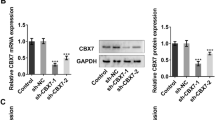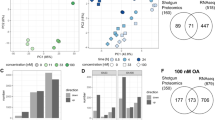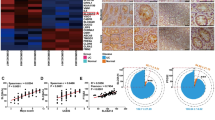Abstract
Cadmium (Cd) is an environmental contaminant, which is potentially toxic. It is well known that Cd can accumulate in the liver and kidney and cause serious damage. However, few studies have investigated the mechanism of intestinal damage induced by Cd in swine. Here, we established Cd poisoning models in vivo and in vitro to explore the mechanism of intestinal injury induced by Cd in swine. The morphology of intestinal tissue cells was observed by TUNEL staining and electron microscopy, and the morphology of IPEC-J2 cells was observed by flow cytometry, Hoechst staining, and MDC staining. Cell morphological observations revealed that Cd treatment induced ileal apoptosis and autophagy. The effects of Cd on the PI3K/Akt pathway, as well as on apoptosis and autophagy-related protein expression in intestinal cells, were analyzed by western blot (WB) and the expression of mRNA was detected by quantitative real-time polymerase chain reaction (qRT-PCR). The results showed that Cd induced autophagy by increasing the levels of autophagy markers Beclin1, Autophagy-associated gene 5 (ATG5), Autophagy-associated gene 16 (ATG16), and Microtubule-associated protein light chains 3–2 (LC3-II), and by reducing the expression levels of Mechanistic target of rapamycin kinase (mTOR) and Microtubule-associated protein light chains 3–1 (LC3-I). Cell apoptosis was induced by increasing the expression of apoptosis markers Bcl-2 associated X protein (Bax), Cysteinyl aspartate specific proteinase 9 (Caspase9), cleaved Caspase9, Cysteinyl aspartate specific proteinase 3 (Caspase3), and cleaved Caspase3, and by reducing the expression of B cell lymphoma/leukemia 2 (Bcl-2). At the same time, Cd decreased the expression of phosphatidylinositol 3-kinase (PI3K), protein kinase B (Akt), and their phosphorylation. We treated IPEC-J2 cells with the PI3K activator 740Y-P and analyzed the morphological changes as well as autophagy and apoptosis-related gene expression. The results showed that 740Y-P could reduce apoptosis and autophagy induced by Cd. In conclusion, our findings suggest that Cd induces intestinal apoptosis and autophagy in swine by inactivating the PI3K/Akt signaling pathway.






Similar content being viewed by others
Data availability
The datasets used and/or analyzed during the current study are available from the corresponding author on reasonable request.
All authors have read the manuscript and agreed to submit it in its current form for consideration for publication in the Journal.
References
Ahumada-Castro U, Silva-Pavez E, Lovy A, Pardo E, Molgό J, Cárdenas C (2019) MTOR-independent autophagy induced by interrupted endoplasmic reticulum-mitochondrial Ca(2+) communication: a dead end in cancer cells. Autophagy 15:358–361
Allaire M, Rautou PE, Codogno P, Lotersztajn S (2019) Autophagy in liver diseases: time for translation? J Hepatol 70:985–998
Andersen O, Nielsen JB, Svendsen P (1988) Oral cadmium chloride intoxication in mice: effects of dose on tissue damage, intestinal absorption and relative organ distribution. Toxicology 48:225–236
Ayres RU (1992) Toxic heavy metals: materials cycle optimization. Proc Natl Acad Sci USA 89:815–820
Bao RK, Zheng SF, Wang XY (2017) Selenium protects against cadmium-induced kidney apoptosis in chickens by activating the PI3K/AKT/Bcl-2 signaling pathway. Environ Sci Pollut Res Int 24:20342–20353
Benoff S, Auborn K, Marmar JL, Hurley IR (2008) Link between low-dose environmentally relevant cadmium exposures and asthenozoospermia in a rat model. Fertil Steril 89:e73-79
Bork U, Lee WK, Kuchler A, Dittmar T, Thévenod F (2010) Cadmium-induced DNA damage triggers G(2)/M arrest via chk1/2 and cdc2 in p53-deficient kidney proximal tubule cells. Am J Physiol Renal Physiol 298:F255-265
Breton J, Daniel C, Vignal C, Body-Malapel M, Garat A, Plé C, Foligné B (2016) Does oral exposure to cadmium and lead mediate susceptibility to colitis? The dark-and-bright sides of heavy metals in gut ecology. Sci Rep 6:19200
Cai J, Guan H, Jiao X, Yang J, Chen X, Zhang H, Zheng Y, Zhu Y, Liu Q, Zhang Z (2021) NLRP3 inflammasome mediated pyroptosis is involved in cadmium exposure-induced neuroinflammation through the IL-1β/IkB-α-NF-κB-NLRP3 feedback loop in swine. Toxicology 453:152720
Cavalcante GC, Schaan AP, Cabral GF, Santana-da-Silva MN, Pinto P, Vidal AF, Ribeiro-Dos-Santos  (2019) A cell’s fate: an overview of the molecular biology and genetics of apoptosis. Int J Mol Sci 20(17):4133
Chen X, Wu W, Gong B, Hou L, Dong X, Xu C, Zhao R, Yu Q, Zhou Z, Huang S, Chen L (2020) Metformin attenuates cadmium-induced neuronal apoptosis in vitro via blocking ROS-dependent PP5/AMPK-JNK signaling pathway. Neuropharmacology 175:108065
Chen X, Bi M, Yang J, Cai J, Zhang H, Zhu Y, Zheng Y, Liu Q, Shi G, Zhang Z (2021) Cadmium exposure triggers oxidative stress, necroptosis, Th1/Th2 imbalance and promotes inflammation through the TNF-α/NF-κB pathway in swine small intestine. J Hazard Mater 421:126704
Chi Q, Zhang Q, Lu Y, Zhang Y, Xu S, Li S (2021) Roles of selenoprotein S in reactive oxygen species-dependent neutrophil extracellular trap formation induced by selenium-deficient arteritis. Redox biology 44:102003
Liu Q, Du P, Zhu Y, Zhang X, Cai J, Zhang Z (2022) Thioredoxin reductase 3 suppression promotes colitis and carcinogenesis via activating pyroptosis and necrosis. Cell Mol Life Sci. https://doi.org/10.1007/s00018-022-04155-y
Chu BX, Fan RF, Lin SQ, Yang DB, Wang ZY, Wang L (2018) Interplay between autophagy and apoptosis in lead(II)-induced cytotoxicity of primary rat proximal tubular cells. J Inorg Biochem 182:184–193
Cz A, Zh A, Rh A, Sp A, Zw A, Chang WA, Fan YA, Cx A, Gn B, Gh AJ, Jo HM (2021) New insights into crosstalk between pyroptosis and autophagy co-induced by molybdenum and cadmium in duck renal tubular epithelial cells. J Hazard Mater 416:126138
Gong Y, Yang J, Cai J, Liu Q, Zhang JM, Zhang Z (2019) Effect of Gpx3 gene silencing by siRNA on apoptosis and autophagy in chicken cardiomyocytes. J Cell Physiol 234:7828–7838
Gong Z, Zhao Y, Wang Z, Fan R, Liu Z (2022) Wang L (2021) Epigenetic regulator BRD4 is involved in cadmium-induced acute kidney injury via contributing to lysosomal dysfunction, autophagy blockade and oxidative stress. J Hazard Mater 423(Pt A):127110
Gu X, Guo W, Zhao Y, Liu G, Wu J, Chang C (2019) Deoxynivalenol-induced cytotoxicity and apoptosis in IPEC-J2 cells through the activation of autophagy by inhibiting PI3K-AKT-mTOR signaling pathway. ACS Omega 4:18478–18486
Miao Z, Miao Z, Wang S, Wu H, Xu S (2021) Exposure to imidacloprid induce oxidative stress, mitochondrial dysfunction, inflammation, apoptosis and mitophagy via NF-kappaB/JNK pathway in grass carp hepatocytes. Fish Shellfish Immunol 120:674–685
Hu X, Chi Q, Wang D, Chi X, Teng X, Li S (2018) Hydrogen sulfide inhalation-induced immune damage is involved in oxidative stress, inflammation, apoptosis and the Th1/Th2 imbalance in broiler bursa of Fabricius. Ecotoxicol Environ Saf 164:201–209
Kalkavan H, Green DR (2018) MOMP, cell suicide as a BCL-2 family business. Cell Death Differ 25:46–55
Kong L, Hu W, Gao X, Wu Y, Xue Y, Cheng K, Tang M (2019) Molecular mechanisms underlying nickel nanoparticle induced rat Sertoli-germ cells apoptosis. The Sci of the Total Environ 692:240–248
Kumar D, Das B, Sen R, Kundu P, Manna A, Sarkar A, Chowdhury C, Chatterjee M, Das P (2015) Andrographolide analogue induces apoptosis and autophagy mediated cell death in U937 cells by inhibition of PI3K/Akt/mTOR pathway. PloS one 10:e0139657
Li J, Zhang W, Zhou P, Tong X, Guo D, & Lin H (2021) Selenium deficiency induced apoptosis via mitochondrial pathway caused by Oxidative Stress in porcine gastric tissues. Res Vet Sci S0034–5288(21)00305-2
Lin YT, Wang HC, Hsu YC, Cho CL, Yang MY, Chien CY (2017) Capsaicin induces autophagy and apoptosis in human nasopharyngeal carcinoma cells by downregulating the PI3K/AKT/mTOR pathway. Int J Mol Sci 18(7):1343
Liu Y, Fan D (2018) Ginsenoside Rg5 induces apoptosis and autophagy via the inhibition of the PI3K/Akt pathway against breast cancer in a mouse model. Food Funct 9:5513–5527
Liu G, Yuan Y, Long M, Luo T, Bian J, Liu X, Gu J, Zou H, Song R, Wang Y, Wang L, Liu Z (2017) Beclin-1-mediated autophagy protects against cadmium-activated apoptosis via the Fas/FasL pathway in primary rat proximal tubular cell culture. Sci Rep 7:977
Liu M, Zhang J, Dong H, Wang W (2019) Nimotuzuma restrains proliferation and induces apoptosis in human osteosarcoma cells by regulation of EGFR/PI3K/AKT signal pathway. J Cell Physiol 234:20879–20887
Liu X, Wang Y, Shang S, Xu S, Guo M (2022) TMT induces apoptosis and necroptosis in mouse kidneys through oxidative stress-induced activation of the NLRP3 inflammasome. Ecotoxicol Environ Saf 230:113167
Lynch SJ, Horgan KA, White B, Walls D (2017) Selenium source impacts protection of porcine jejunal epithelial cells from cadmium-induced DNA damage, with maximum protection exhibited with yeast-derived selenium compounds. Biol Trace Elem Res 176:311–320
Ma Y, Ran D, Zhao H, Song R, Zou H, Gu J, Yuan Y, Bian J, Zhu J, Liu Z (2021) Cadmium exposure triggers osteoporosis in duck via P2X7/PI3K/AKT-mediated osteoblast and osteoclast differentiation. The Sci of the total environ 750:141638
Madan E, Prasad S, Roy P, George J, Shukla Y (2008) Regulation of apoptosis by resveratrol through JAK/STAT and mitochondria mediated pathway in human epidermoid carcinoma A431 cells. Biochem Biophys Res Commun 377:1232–1237
Manthari RK, Tikka C, Ommati MM, Niu R, Sun Z, Wang J, Zhang J, Wang J (2018) Arsenic induces autophagy in developmental mouse cerebral cortex and hippocampus by inhibiting PI3K/Akt/mTOR signaling pathway: involvement of blood-brain barrier’s tight junction proteins. Arch Toxicol 92:3255–3275
Mizushima N, Yoshimori T, Levine B (2010) Methods in mammalian autophagy research. Cell 140:313–326
Nenci A, Becker C, Wullaert A, Gareus R, van Loo G, Danese S, Huth M, Nikolaev A, Neufert C, Madison B, Gumucio D, Neurath MF, Pasparakis M (2007) Epithelial NEMO links innate immunity to chronic intestinal inflammation. Nature 446:557–561
Ni HJ, Liu FF, Liang X, Yin YL, Liu G (2020) The role of zinc chelate of hydroxy analogue of methionine in cadmium toxicity: effects on cadmium absorption on intestinal health in piglets. Anim : an Int J of Anim Biosci 14:1382–1391
Ninkov M, Popov Aleksandrov A, Demenesku J, Mirkov I, Mileusnic D, Petrovic A, Grigorov I, Zolotarevski L, Tolinacki M, Kataranovski D, Brceski I, Kataranovski M (2015) Toxicity of oral cadmium intake: Impact on gut immunity. Toxicol Lett 237:89–99
Otomo C, Metlagel Z, Takaesu G, Otomo T (2013) Structure of the human ATG12~ATG5 conjugate required for LC3 lipidation in autophagy. Nat Struct Mol Biol 20:59–66
Pesonen M, Vähäkangas K (2019) Autophagy in exposure to environmental chemicals. Toxicol Lett 305:1–9
Popgeorgiev N, Jabbour L, Gillet G (2018) Subcellular localization and dynamics of the Bcl-2 family of proteins. Front in Cell and Dev Biol 6:13
Ren X, Wang S, Zhang C, Hu X, Zhou L, Li Y, Xu L (2020) Selenium ameliorates cadmium-induced mouse leydig TM3 cell apoptosis via inhibiting the ROS/JNK /c-jun signaling pathway. Ecotoxicol and environ saf 192:110266
Shen X Tang Z Bai Y Wan M Yu M Chen J Li G Zhang R Ge M (2021) Astragalus polysaccharide protects against cadmium-induced autophagy injury through reactive oxygen species (ROS) pathway in chicken embryo fibroblast. Biol Trace Elem Res 200(1):318–329
Shengchen W, Jing L, Yujie Y, Yue W, Shiwen X (2021) Polystyrene microplastics-induced ROS overproduction disrupts the skeletal muscle regeneration by converting myoblasts into adipocytes. J of hazard mater 417:125962
Shi Q, Jin X, Fan R, Xing M, Guo J, Zhang Z, Zhang J, Xu S (2019) Cadmium-mediated miR-30a-GRP78 leads to JNK-dependent autophagy in chicken kidney. Chemosphere 215:710–715
Skipper A, Sims JN, Yedjou CG, Tchounwou PB (2016) Cadmium chloride induces DNA damage and apoptosis of human liver carcinoma cells via oxidative stress. International Journal of Environmental Research and Public Health 13(1):88
Son Y, Cho Y, Saha A, Kwon H, Park J, Kim M, Jung Y, Kim S, Choi C, Seong J, Burl R, Granneman J, Lee Y (2020) Adipocyte-specific Beclin1 deletion impairs lipolysis and mitochondrial integrity in adipose tissue. Mol metab 39:101005
Song N, Li X, Cui Y, Zhang T, Xu S, Li S (2021) Hydrogen sulfide exposure induces pyroptosis in the trachea of broilers via the regulatory effect of circRNA-17828/miR-6631–5p/DUSP6 crosstalk on ROS production. J of hazard mater 418:126172
Wang C, Nie G, Zhuang Y, Hu R, Wu H, Xing C, Li G, Hu G, Yang F, Zhang C (2020) Inhibition of autophagy enhances cadmium-induced apoptosis in duck renal tubular epithelial cells. Ecotoxicol and environ saf 205:111188
Wang J, Zhu H, Wang K, Yang Z, Liu Z (2020b) Protective effect of quercetin on rat testes against cadmium toxicity by alleviating oxidative stress and autophagy. Environ Sci Pollut Res Int 27:25278–25286
Xie D, Li Y, Liu Z, Chen Q (2019) Inhibitory effect of cadmium exposure on digestive activity, antioxidant capacity and immune defense in the intestine of yellow catfish (Pelteobagrus fulvidraco). Comparative biochemistry and physiology. Toxicol & Pharmacol : CBP 222:65–73
Xiong X, Zhang Y, Xing H, Xu S (2020) Ameliorative effect of selenomethionine on cadmium-induced hepatocyte apoptosis via regulating PI3K/AKT pathway in chickens. Biol Trace Elem Res 195:559–568
Yang J, Shi G, Gong Y, Cai J, Zheng Y, Zhang Z (2021) LncRNA 0003250 accelerates heart autophagy and binds to miR-17-5p as a competitive endogenous RNA in chicken induced by selenium deficiency. J Cell Physiol 236:157–177
Yuan W, Liang L, Huang K, Deng Y, Dong M, Wang G, Zou F (2020) MiR-122-5p and miR-326-3p promote cadmium-induced NRK-52E cell apoptosis by downregulating PLD1. Environ Toxicol 35:1334–1342
Zhang J, Zheng S, Wang S, Liu Q, Xu S (2020) Cadmium-induced oxidative stress promotes apoptosis and necrosis through the regulation of the miR-216a-PI3K/AKT axis in common carp lymphocytes and antagonized by selenium. Chemosphere 258:127341
Zhao H, Wang Y, Liu Y, Yin K, Wang D, Li B, Yu H, Xing M (2021) ROS-induced hepatotoxicity under cypermethrin: involvement of the crosstalk between Nrf2/Keap1 and NF-κB/iκB-α pathways regulated by proteasome. Environ Sci Technol 55:6171–6183
Zheng J, Zhuo L, Ran D, Ma Y, Luo T, Zhao H, Song R, Zou H, Zhu J, Gu J, Bian J, Yuan Y, Liu Z (2020) Cadmium induces apoptosis via generating reactive oxygen species to activate mitochondrial p53 pathway in primary rat osteoblasts. Toxicology 446:152611
Zheng Y, Guan H, Yang J, Cai J, Liu Q, Zhang Z (2021) Calcium overload and reactive oxygen species accumulation induced by selenium deficiency promote autophagy in swine small intestine. Anim Nutr 7:997–1008
Funding
This study was supported by the Heilongjiang Provincial Natural Science Foundation for Outstanding Youth (YQ2021C021), the Earmarked Fund for China Agriculture Research System (No. CARS 35–04), the postdoctoral scientific research developmental fund of Heilongjiang Province (LBH-Q18018), and the Central Public-interest Scientific Institution Basal Research Fund (2020TD22).
Heilongjiang Provincial Natural Science Foundation for Outstanding Youth,YQ2021C021,Ziwei Zhang,Earmarked Fund for China Agriculture Research System,No. CARS 35–04,Ziwei Zhang,Heilongjiang Provincial Postdoctoral Science Foundation,LBH-Q18018,Ziwei Zhang,Central Public-interest Scientific Institution Basal Research Fund,Chinese Academy of Fishery Sciences,2020TD22,Ziwei Zhang
Author information
Authors and Affiliations
Contributions
Haoran Zhang: conceptualization, methodology, investigation, writing—original draft. Jiaqiang Huang: methodology, investigation, formal analysis. Jie Yang: investigation, formal analysis, methodology. Jingzeng Cai: software, visualization, formal analysis. Qi Liu: methodology, validation. Xintong Zhang: methodology, investigation. Jun Bao: conceptualization, investigation, methodology, writing—review and editing. Ziwei Zhang: conceptualization, methodology, writing—review and editing, funding acquisition.
Corresponding author
Ethics declarations
Ethics approval and consent to participate
All procedures in this study were carried out in accordance with the European Community Council Directive (86/609/EEC) and approved by the Institutional Animal Care and Use Committee of Northeast Agricultural University (SRM-11).
Consent for publication
Not applicable.
Competing interests
The authors declare no competing interests.
Additional information
Responsible Editor: Mohamed M. Abdel-Daim
Publisher's Note
Springer Nature remains neutral with regard to jurisdictional claims in published maps and institutional affiliations.
Supplementary Information
Below is the link to the electronic supplementary material.
Rights and permissions
About this article
Cite this article
Zhang, H., Huang, J., Yang, J. et al. Cadmium induces apoptosis and autophagy in swine small intestine by downregulating the PI3K/Akt pathway. Environ Sci Pollut Res 29, 41207–41218 (2022). https://doi.org/10.1007/s11356-022-18863-2
Received:
Accepted:
Published:
Issue Date:
DOI: https://doi.org/10.1007/s11356-022-18863-2




